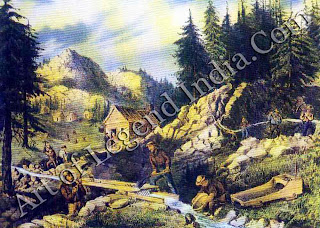 A Year in the Life 1848
A Year in the Life 1848
As
Courbet watched the mob mount the barricades in Paris, the shock waves of
revolution reverberated throughout Europe. In Germany and Italy there was a
series of violent uprisings, and in England there were ugly scenes in Trafalgar
Square. Meanwhile, King Louis Philippe had fled France and, more sensationally,
a gigantic sea serpent had been sighted off the African coast.
Everyone
agreed that it was a most dramatic year. Popular writers vied with each other
to find words grand enough to describe it. 'The year 1848', declared one, 'will
be hereafter known as that of the great and general revolt of nations against
their rulers.' A more cynical observer was heartily relieved when it was over.
'One cannot but feel glad,' he noted in his diary, 'at getting rid of a year
which has been so pregnant with every sort of mischief.'
THE COMMUNIST MANIFESTO
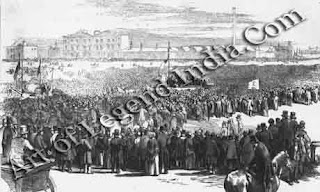 But the
real words of power for 1848 had already been written when the year began and
were in the hands of a London printer. 'Workers of the world, unite!' they ran,
'You have nothing to lose but your chains. You have a world to win.' The
printer's client was a German refugee called Karl Marx and his commission was
The Communist Manifesto.
But the
real words of power for 1848 had already been written when the year began and
were in the hands of a London printer. 'Workers of the world, unite!' they ran,
'You have nothing to lose but your chains. You have a world to win.' The
printer's client was a German refugee called Karl Marx and his commission was
The Communist Manifesto.
The
first rumblings of revolution came from Sicily in January, but they were not
taken very seriously for Sicily was a notoriously volatile and lawless region.
Then on 24 February the moderate middle-class monarchy of King Louis Philippe
in France fell with startling suddenness. In the early hours of the morning,
during a large demonstration outside the Ministry of Foreign Affairs in Paris,
a man from the crowd walked up to the officer in command of the guard and shot
him dead.
This
had the intended effect of making the soldiers fire on the demonstrators,
several of whom were killed. Their bodies were paraded through the streets in a
cart to the accompaniment of revolutionary songs remembered from the 1790s.
Barricades were set up, some 1,500 altogether, and by daybreak the mob was in
complete control of the city centre.
Louis
Philippe abdicated in favour of his grandson, a boy of 10, but the leaders of
the revolution brushed aside the boy's claims and proclaimed a republic.
Courbet did a drawing of a man at the barricade, to serve as a cover design for
a revolutionary journal. 'Without 1848,' he said later, painting would not have
happened.'
The
first reaction came early in March from Hungary, where nationalist leaders
demanded and obtained concessions from their Austrian rulers in Vienna. Then
there was an uprising in Vienna itself, which forced the Emperor of
Austria-Hungary to grant a new and liberal constitution to his people. The King
of Prussia made similar concessions after an uprising in Berlin which left
hundreds of demonstrators and troops dead. Revolutions followed in other German
kingdoms and a national assembly for the whole of Germany was convened at
Frankfurt, dedicated to sweeping away the existing petty principalities and
creating a united Germany.
UPRISINGS IN ITALY
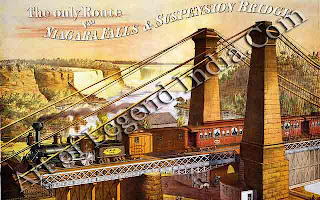 In
Italy, too, a series of revolutions led to a movement for national unity. After
popular uprisings had driven the Austrian occupying forces out of Milan and
Venice, the King of Sardinia later to be joined by the Grand Duke of Tuscany
embarked on a war to unify the country. The declaration of war came on 24 March.
It had taken just a month for the shock waves from Paris to bring down the
European state system from the Baltic to the southernmost tip of Italy.
In
Italy, too, a series of revolutions led to a movement for national unity. After
popular uprisings had driven the Austrian occupying forces out of Milan and
Venice, the King of Sardinia later to be joined by the Grand Duke of Tuscany
embarked on a war to unify the country. The declaration of war came on 24 March.
It had taken just a month for the shock waves from Paris to bring down the
European state system from the Baltic to the southernmost tip of Italy.
From
all over Europe refugees streamed into Britain, some of them conservatives who
had been toppled and others revolutionaries who had been too extreme. The first
to arrive was Louis Philippe, who landed at Newhaven in the early hours of the
morning on 3 March. He wore a jacket borrowed from the captain of the ship that
had brought him, and he had a week's growth of beard on his face. The Queen was
muffled in a large plaid cloak, with a heavy veil to hide her face.
One Mr.
Stone,' the newspapers reported, 'signalized himself by recognizing the King from
afar off in the boat that brought him ashore.' Mr. Stone welcomed the deposed monarch,
assuring him that the British would protect him from his enemies, and Louis
Philippe, 'much agitated', gave him grateful thanks. The King then took refuge
in coincidence, observing that he had travelled as 'Mr. Smith' and that he now
found the landlady of the inn at which he stayed, as well as the Rector of
Newhaven, had the same reassuring name.
PROTESTS IN TRAFALGAR SQUARE
Three
days later the British had their own first taste of revolutionary activity,
when a certain Mr. Cochrane organized a demonstration in Trafalgar Square to
protest against the income tax. Since only the rich paid the tax, it was not a
very popular cause; and it became even less popular when Cochrane was scared
off by a government ban on the meeting.
His
supporters amused themselves by tearing down the fences around the column being
erected to the memory of Lord Nelson. On the same day there were uglier
troubles further north and cries of 'Vive la Republique!' were heard.
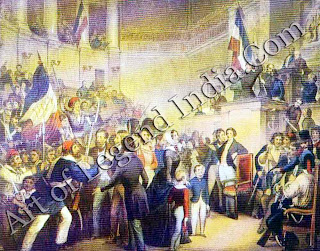 The
authorities took fright and began to enrol special constables to deal with an
enormous demonstration due to take place in London in April, when hundreds of
thousands of radicals would present a petition for the reform of Parliament.
One of the constables was Louis-Napoleon Bonaparte, nephew of the Napoleon
Bonaparte who had once sought to invade Britain. He was responsible for the
area between Park Lane and Dover Street, but in the event he had little to do.
The demonstration came to nothing and its petition was rejected.
The
authorities took fright and began to enrol special constables to deal with an
enormous demonstration due to take place in London in April, when hundreds of
thousands of radicals would present a petition for the reform of Parliament.
One of the constables was Louis-Napoleon Bonaparte, nephew of the Napoleon
Bonaparte who had once sought to invade Britain. He was responsible for the
area between Park Lane and Dover Street, but in the event he had little to do.
The demonstration came to nothing and its petition was rejected.
In August
there came news sufficiently sensational to crowd out revolutions and radicals.
The officers of a ship sailing off the African coast reported the sighting of a
sea serpent over 100 feet long. Scientists said they were deluded and a fierce
public controversy ensued, in the course of which most of the European
revolutions collapsed without a great deal of attention being paid to them.
In the
autumn Louis-Napoleon slipped across to France and was elected President of the
French Republic. He might have had little to do in London, but in Paris he
meant to maintain law and order. Courbet read the signs and began work on his
great picture The Burial at Ornans. Its real subject, he insisted, was the
death of romantic idealism and the acceptance of reality. The heady days of
1848 were over.
Writer – Marshall
Cavendish
 But the
real words of power for 1848 had already been written when the year began and
were in the hands of a London printer. 'Workers of the world, unite!' they ran,
'You have nothing to lose but your chains. You have a world to win.' The
printer's client was a German refugee called Karl Marx and his commission was
The Communist Manifesto.
But the
real words of power for 1848 had already been written when the year began and
were in the hands of a London printer. 'Workers of the world, unite!' they ran,
'You have nothing to lose but your chains. You have a world to win.' The
printer's client was a German refugee called Karl Marx and his commission was
The Communist Manifesto.  In
Italy, too, a series of revolutions led to a movement for national unity. After
popular uprisings had driven the Austrian occupying forces out of Milan and
Venice, the King of Sardinia later to be joined by the Grand Duke of Tuscany
embarked on a war to unify the country. The declaration of war came on 24 March.
It had taken just a month for the shock waves from Paris to bring down the
European state system from the Baltic to the southernmost tip of Italy.
In
Italy, too, a series of revolutions led to a movement for national unity. After
popular uprisings had driven the Austrian occupying forces out of Milan and
Venice, the King of Sardinia later to be joined by the Grand Duke of Tuscany
embarked on a war to unify the country. The declaration of war came on 24 March.
It had taken just a month for the shock waves from Paris to bring down the
European state system from the Baltic to the southernmost tip of Italy.  The
authorities took fright and began to enrol special constables to deal with an
enormous demonstration due to take place in London in April, when hundreds of
thousands of radicals would present a petition for the reform of Parliament.
One of the constables was Louis-Napoleon Bonaparte, nephew of the Napoleon
Bonaparte who had once sought to invade Britain. He was responsible for the
area between Park Lane and Dover Street, but in the event he had little to do.
The demonstration came to nothing and its petition was rejected.
The
authorities took fright and began to enrol special constables to deal with an
enormous demonstration due to take place in London in April, when hundreds of
thousands of radicals would present a petition for the reform of Parliament.
One of the constables was Louis-Napoleon Bonaparte, nephew of the Napoleon
Bonaparte who had once sought to invade Britain. He was responsible for the
area between Park Lane and Dover Street, but in the event he had little to do.
The demonstration came to nothing and its petition was rejected. 

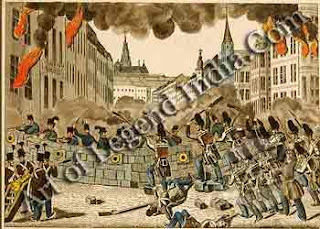
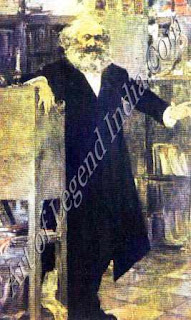










0 Response to "French Great Artist Gustave Courbet - A Year in the Life 1848"
Post a Comment